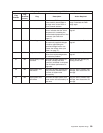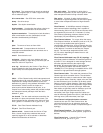C
C. See Celsius.
capacity. The amount of data that can be contained
on storage media and expressed in bytes.
cartridge. See tape cartridge.
cartridge door. On a tape cartridge, the hinged barrier
that can be opened to access, or closed to protect, the
magnetic tape within the cartridge.
cartridge manual rewind tool. A device that can be
fitted into the reel of a cartridge and used to rewind tape
into or out of the cartridge.
cartridge memory. See LTO cartridge memory.
Celsius. Having a thermometric scale on which the
interval between the freezing point and the boiling point
of water is divided into 100 degrees, with 0°
representing the freezing point and 100° representing
the boiling point.
channel calibration. A feature of the Ultrium 2 Tape
Drive by which it automatically customizes each
read/write data channel to compensate for variations in
such things as the recording channel’s transfer function,
the media, and characteristics of the drive head.
Channel calibration optimizes system performance.
circuit board. A thin sheet on which chips and other
electronic components are placed. Computers consist of
one or more boards, often called cards or adapters.
cleaning cartridge. A tape cartridge that is used to
clean the heads of a tape drive. Contrast with data
cartridge.
clockwise. In the direction that the hands of a clock
rotate, as viewed from the front.
command time-out. Following the issuance of a
command, a period of time during which it is determined
that there is a bad connection between the server and
the drive.
compression. The process of eliminating gaps, empty
fields, redundancies, and unnecessary data to shorten
the length of records or blocks.
configure. To describe to a server the devices,
optional features, and programs installed on the system.
contiguous. Touching along a boundary or at a point.
core. The light-conducting central portion of an optical
fiber. The core is composed of material that has a
higher index of refraction than the cladding (the material
that surrounds the core).
counterclockwise. In a direction opposite to that in
which the hands of a clock rotate, as viewed from the
front.
current. The quantity of charge per unit of time.
Current is measured in amperes.
cycle power. To apply and remove electrical power to
a device within a short time span.
D
data. Any representations such as characters or
analog quantities to which meaning is, or might be,
assigned.
data cartridge. A tape cartridge that is dedicated to
storing data. Contrast with cleaning cartridge.
data compression. See compression.
data transfer rate. The average number of bits,
characters, or blocks per unit of time that pass between
corresponding equipment in a data transmission system.
The rate is expressed in bits, characters, or blocks per
second, minute, or hour.
dc. Direct current.
degauss. To make a magnetic tape nonmagnetic by
exposing the tape to electrical coils which carry currents
that neutralize the magnetism of the tape.
device. Any hardware component or peripheral, such
as a tape drive or tape library, that can receive and
send data.
device driver. A file that contains the firmware that is
needed to use an attached device.
diagnostic. A software program that is designed to
recognize, locate, and explain faults in equipment or
errors in programs.
diagnostic cartridge. A tape cartridge that enables
the detection and isolation of errors in programs and
faults in equipment.
direct current (dc). An electric current flowing in one
direction only and substantially constant in value.
director-class switch. A high-end switch that includes
such qualities as fault tolerance, high throughput, high
reliability, port density, and so forth.
drive. See IBM TotalStorage LTO Ultrium 2 Tape
Drive.
drive dump. The recording, at a particular instant, of
the contents of all or part of one storage device into
another storage device, usually as a safeguard against
faults or errors, or in connection with debugging.
106 IBM TotalStorage LTO Ultrium 2 Tape Drive


















